Video Lecture
Theory For Making Notes
Types of Solids
A solid is that state of matter in which its constituent atoms or molecules are held strongly at the position of minimum potential energy and it has a definite shape and volume. The solids can be classified into two categories, crystalline and glassy or amorphous solids.
Different Properties of Matter
(1) Elasticity :
The property of matter by virtue of which a body tends to regain its original shape and size after the removal of deforming force is called elasticity.
(2) Plasticity :
The property of matter by virtue of which it does not regain its original shape and size after the removal of deforming force is called plasticity.
(3) Elastic limit :
Elastic bodies show their property of elasticity upto a certain value of deforming force. If we go on increasing the deforming force then a stage is reached when on removing the force, the body will not return to its original state. The maximum deforming force upto which a body retains its property of elasticity is called elastic limit of the material of body.
Elastic limit is the property of a body whereas elasticity is the property of material of the body.
Stress
When a force is applied on a body, there will be relative displacement of the particles and due to property of elasticity, an internal restoring force is developed which tends to restore the body to its original state.
The internal restoring force acting per unit area of cross section of the deformed body is called stress.
If external force F is applied on the area A of a body then,
Stress =\frac{{\text{Force }}}{{\text{Area}}}=\frac{F}{A}
Unit : N/{{m}^{2}} (S.I.) , dyne/c{{m}^{2}} (C.G.S.)
Dimension : [M{{L}^{{-1}}}{{T}^{{-2}}}]
Stress developed in a body depends upon how the external forces are applied over it.
On this basis there are different types of stresses :
(i) Longitudinal Stress
(ii) Volumetric Stress
(iii) Shear or tangential stress
(i)
Longitudinal stress
(a) It occurs only in solids and comes in to picture when deforming force is applied parallel to the length and causes increase in length as shown in the figure.

In this case the restoring force induced per unit area is called longitudinal stress. The area taken for calculation of stress is the area of cross section. Longitudinal stress produced due to increase in length of a body under a deforming force is called tensile stress. Whereas the Longitudinal stress produced due to decrease in length of a body under a deforming force is called compressive stress.
Volumetric Stress
This type of stress is produced when deforming force is applied normally to the surface at all points as shown in the figure.
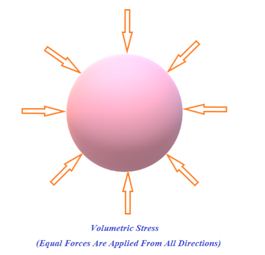
In such situations the restoring force induced per unit area is called Volumetric stress or Hydrostatic stress. It occurs in solids, liquids and gases. This stress produces change in volume and density, shape remaining same. For calculation of this stress the complete surface area perpendicular to the applied forces is used. It is equal to change in pressure because change in pressure is responsible for change in volume.
Shear or tangential stress :
It comes into picture when successive layers of solid move on each other i.e. when there is a relative displacement between various layers of solid. Here deforming force is applied tangential to the faces as shown in the figure

To calculate this stress the area of the face on which force is applied is taken into consideration.
Strain
The ratio of change in configuration to the original configuration is called strain.
Being the ratio of two like quantities, it has no dimensions and units.
Strain are of three types :
Linear or Longitudinal strain :

If the deforming force produces a change in length alone, the strain produced in the body is called linear strain or longitudinal strain.
\text{Linear strain}=\frac{{\text{Change in length(}\Delta l\text{)}}}{{\text{Original length(}l\text{)}}}
Linear strain in the direction of deforming force is called longitudinal strain and in a direction perpendicular to force is called lateral strain.
Volumetric strain :
If the deforming force produces a change in volume alone the strain produced in the body is called volumetric strain.
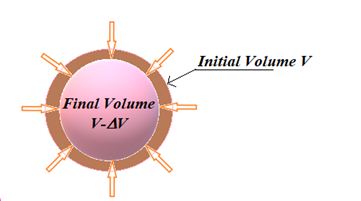
\text{Volumetric strain}=\frac{{\text{Change in volume(}\Delta V\text{)}}}{{\text{Original volume(}V\text{)}}}
Shearing strain :
If the deforming force produces a change in the shape of the body without changing its volume, strain produced is called shearing strain.
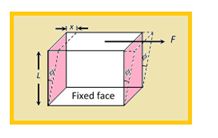
It is defined as angle in radians through which a plane perpendicular to the fixed surface of the cubical body gets turned under the effect of tangential force.
\varphi =\frac{x}{L}
Hooke’s law and moduli of elasticity
According to Hooke’s law, “within elastic limit stress is proportional to strain”

i.e. \frac{{\text{stress}}}{{\text{strain}}}= constant = λ
where λ is called modulus of elasticity. Depending upon different types of strain the following three moduli of elasticity are possible.
(i) Young’s modulus:
When a wire or rod is stretched by a longitudinal force, the ratio of the longitudinal stress to the longitudinal strain within the elastic limits is called Young’s modulus.
Young’s modulus (Y) = \frac{{\text{Longitudinal}\ \ \text{stress}}}{{\text{Linear}\ \ \text{strain}}}
Consider a wire or rod of length L and radius r under the action of a stretching force F applied normal to its faces. Suppose the wire suffers a change in length l then
Longitudinal stress = \frac{F}{{\pi {{r}^{2}}}}
Linear strain = \frac{l}{L}
Young’s modulus (Y) = \frac{{\frac{F}{{\pi {{r}^{2}}}}}}{{\frac{l}{L}}}= \frac{{FL}}{{\pi {{r}^{2}}l}}
(ii) Bulk modulus:
When a solid or fluid (liquid or gas) is subjected to a uniform pressure all over the surface, the shape remains the same, but there is a change in the volume. The force per unit area applied normally and uniformly over the surface is called normal stress. The change in volume per unit volume is called volume or bulk strain. The ratio \frac{{\text{Volume}\ \,\text{stress}\,\,\ \text{or}\,\,\ \text{normal}\,\,\,\ \text{stress}}}{{\text{Volume}\,\,\,\text{strain}}} is called bulk modulus (B).
In symbol B = – \frac{F}{{\frac{A}{{\frac{{\Delta V}}{V}}}\,}}\,=\,\,-\,\frac{{FV}}{{A\Delta V}}=-\frac{P}{{\Delta V/V}}
The reciprocal of bulk modulus is called compressibility (K).
Compressibility (K) = \frac{1}{{\text{bulk}\ \,\,\text{modulus}}}
Density of Compressed Liquid
If a liquid of density \rho , volume V and bulk modulus K is compressed, then its density increases.
As density \rho =\frac{m}{V} so \frac{{\Delta \rho }}{\rho }=\frac{{-\Delta V}}{V} …(i)
But by definition of bulk modulus
K=\frac{{-V\Delta P}}{{\Delta V}} ⇒ -\frac{{\Delta V}}{V}=\frac{{\Delta P}}{K} …(ii)
From (i) and (ii) \frac{{\Delta \rho }}{\rho }= \frac{{{\rho }’-\rho }}{\rho }=\frac{{\Delta P}}{K} [As Dr = r’ – r ]
or {\rho }’=\rho \left[ {1+\frac{{\Delta P}}{K}} \right] =\rho [1+C\Delta P] \left[ {\text{As }\frac{\text{1}}{K}=C} \right]
(iii) Modulus of Rigidity:
According to definition, the ratio of shearing stress to shearing strain is called modulus of rigidity (h). In this case the shape of the body changes but its volume remains unchanged. Consider the case of a cube fixed at its lower face and acted upon by a tangential force F on its upper surface of area A as shown in figure.
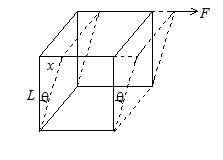
shearing stress = \frac{F}{A}
shearing strain = θ = \left( {\frac{x}{L}} \right)
η = \frac{F}{{A\theta }}
Elastic energy stored in a deformed body
The elastic energy is measured in terms of work done in straining the body up to its
elastic limit.
Let F be the force applied across the cross-section A of a wire of length L. Let l be the increase in length. Then
Y = \frac{{\ \ \frac{F}{A}\ \ }}{{\frac{l}{L}}}\ =\ \frac{{FL}}{{A\ \ l}} or F = \frac{{Y\ A\ \ l}}{L}
If the wire is stretched through a further distance (d l) the work done = F´ (dl) = \frac{{Y\ A\ \ l}}{L}\ \,\ (dl)
Total work done in stretching the wire from original length L to a length (L + l)
(i.e. from l = 0 to l = l)
W = \int\limits_{0}^{l}{{\frac{{Y\ A\ \cdot \ l}}{L}\ \cdot \ dl}} = \frac{{YA}}{L}\ \cdot \ \frac{{{{l}^{2}}}}{2}\ \ =\ \ \frac{1}{2}\ \ (AL)\ \ \left( {\frac{{Yl}}{L}} \right)\ \ \left( {\frac{l}{L}} \right)
W = 1/2´ volume ´ stress ´ strain
\frac{{\text{Workdone}}}{{\text{Volume}}}=\frac{1}{2}\times \text{stress strain}=\text{Elastic energy}.
Stress-strain Curve
If a curve is plotted on the graph between stress (or load) and longitudinal strain (or elongation) by gradually increasing the load on a vertically suspended metal wire, we get the curve as shown in figure. This curve is called stress – strain curve.

From this curve following observations can be drawn.
(1)
For small strain (< 2%) (i.e., in region OP) stress is proportional to strain. This is the region where Hooke’s law is obeyed. The point P is called elastic limit and slope of line OP gives the Young’s modulus Y of the material of the wire. If θ is the angle of OP from strain axis then young’s modulus Y = tanθ.
(2)
If the strain is increased a little bit, i.e., in the region PE, the stress is not proportional to strain. However, the wire still regains its original length after the removal of stretching force. This behavior is shown up to point E known as yield-point. The region OPE represents the elastic region of the material of wire.
(3)
If the wire is stretched beyond point E, i.e., between EA, the strain increases much more rapidly and if the stretching force is removed the wire does not come back to its natural length. Some permanent increase in length takes place.
(4)
If the stress is increased further, by a very small increase in it a very large increase in strain is produced (region AB) and after reaching point B, the strain increases even if the wire is unloaded and ruptures at C. The maximum stress corresponding to B after which the wire begins to flow and breaks is called breaking or ultimate tensile strength. The region EABC represents the plastic behavior of the material of wire.
Elastic Hysteresis
When a deforming force is applied on a body then the strain does not change simultaneously with stress rather it lags behind the stress. The lagging of strain behind the stress is defined as elastic hysteresis. This is the reason why the values of strain for same stress are different while increasing the load and while decreasing the load.
Hysteresis loop :
The area of the stress-strain curve is called the hysteresis loop and it is numerically equal to the work done in loading the material and then unloading it.
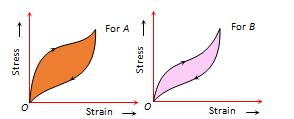
If we have two tyres of rubber having different hysteresis loop then rubber B should be used for making the car tyres. It is because of the reason that area under the curve i.e. work done in case of rubber B is lesser and hence the car tyre will not get excessively heated and rubber A should be used to absorb vibration of the machinery because of the large area of the curve, a large amount of vibrational energy can be dissipated.
Factors Affecting Elasticity
(1)
Hammering and rolling :Crystal grains break up into smaller units by hammering and rolling. This results in increase in the elasticity of material.
(2)
Annealing : The metals are annealed by heating and then cooling them slowly. Annealing results in decrease in the elasticity of material.
(3)
Temperature : Intermolecular forces decreases with rise in temperature. Hence the elasticity decreases with rise in temperature but the elasticity of invar steel (alloy) does not change with change of temperature.
(4)
Impurities : Due to impurities in a material, elasticity can increase or decrease. The type of effect depends upon the nature of impurities present in the material.
Poisson’s ratio:
When a longitudinal force is applied on a wire, its length increases but its radius decreases. Thus two strains are produced by a single force:
(i) Longitudinal strain =\frac{{\Delta l}}{l} and
(ii) Lateral strain =\frac{{\Delta R}}{R}
The ratio of these two strains is called the Poisson’s ratio.
Thus, the Poisson’s ratio \text{ }\!\!\sigma\!\!\text{ }=\frac{{\text{(–) Lateral}\,\text{strain}}}{{\text{Longitudinal}\ \text{strain}}}
Following points are important in case of Poisson’s ratio:
(i) Negative sign in s indicates that radius of the wire decreases as the length increases.
(ii) Theoretical value of s lies between –1 and +\frac{1}{2}.
(iii) Practical value of s lies between 0 and +\frac{1}{2}.
8 Relation between Y (Young’s Modulus), B(Bulk Modulus), h(Modulus of rigidity) and s(Poisson’s ratio):
Following are some relations between the four
(a) B=\frac{Y}{{3(1-2\sigma )}}
(b) \eta =\frac{Y}{{2(1+\sigma )}}
(c) \sigma =\frac{{3B-2\eta }}{{2\eta +6B}}
(d) \frac{9}{Y}=\frac{1}{B}+\frac{3}{\eta }.
Illustration
A wire is stretched by 2 mm when a force of 250 N is applied. Determine the force that would stretch the wire by 5 mm assuming that the elastic limit is not exceeded.
Solution:
According to Hooke’s law, within elastic limits, xµF
or x = kF where k is a constant.
It is given that when x = 2 mm, F = 250 N
\frac{2}{{250}}=\frac{S}{F}
or the force required F = \frac{5}{2}\ \,\,\times \ \,\,250 = 625 N
Illustration
The rubber cord of catapult has a cross-sectional area 1 mm2 and total unstretched length 10 cm. It is stretched to 12 cm and then released to project a body of mass 5 gm. Taking the Young’s modulus of rubber as 5 ´ 108 N/m2, calculate the velocity of projection.
Solution:
It can be assumed that the total elastic energy of catapult is converted into kinetic energy of body without any heat loss.
Elastic energy = 1/2 x load x extension
Extension = 12 – 10 = 2 cm = 2 x 10–2m
Y = \frac{{FL}}{{A\Delta L}}
F = \frac{{5\ \,\times \,\ {{{10}}^{8}}\,\ \times \,\ 1\,\ \times \,\ {{{10}}^{{-6}}}\ \,\times \,\ 2\ \,\times \ \,{{{10}}^{{-2}}}}}{{10\ \,\times \ \,{{{10}}^{{-2}}}}} = 100 N
If v is the velocity of projection,
Elastic energy of catapult = Kinetic energy of missile
½ x load x extension = \frac{1}{2}m{{v}^{2}}
\frac{1}{2}\ \,\times \ \,100\ \,\times \ \,2\ \,\times \ \,{{10}^{{-2}}} = \frac{1}{2}\ \,\times \ \,5\ \,\times \ \,{{10}^{{-3}}}\ \times \ \,{{v}^{2}}
v2 = \frac{{100\ \,\times \ \,{{{10}}^{{-2}}}\ \times \ \,2}}{{5\,\ \times \,\ {{{10}}^{{-3}}}}} = 400
v = 20 m/s
Illustration
A bar of mass m and length l is hanging from point A as shown in figure. Find the increase in its length due to its own weight. The Young’s modulus of elasticity of the wire Y and area of cross-section of the wire is A.

Solution:
Consider a small section dx of the bar at a distance x from B. The weight of the bar for a length x is,

W=\left( {\frac{{mg}}{l}} \right)x
Elongation in section dx will be dl=\left( {\frac{W}{{AY}}} \right)dx =\left( {\frac{{mg}}{{lAY}}} \right)x\,dx
Total elongation in the bar can be obtained by integrating this expression for x = 0 to x = l.
\Delta l=\int_{{x=0}}^{{x=l}}{{\,dl}} =\left( {\frac{{mg}}{{lAY}}} \right)\int_{0}^{l}{{x\,dx}}
or \Delta l=\frac{{mgl}}{{2AY}}
Illustration
(a) A wire 4m long and 0.3 mm in diameter is stretched by a force of 100N. If extension in the wire is 0.3 mm, calculate the potential energy stored in the wire.
(b) Find the work done in stretching a wire of cross-section 1 mm2 and length 2m through 0.1 mm. Young’s modulus for the material of wire is 2.0 × 1011 N/m2.
Solution:
(a) Energy stored U=\frac{1}{2} (stress) (strain) (volume)
Or U=\frac{1}{2}\left( {\frac{F}{A}} \right)\left( {\frac{{\Delta l}}{l}} \right)(Al) =\frac{1}{2}F.\Delta l =\frac{1}{2}(100)(0.3\times {{10}^{{-3}}}) = 0.015 J.
(b) Work done = Potential energy stored
=\frac{1}{2}k{{(\Delta l)}^{2}} =\frac{1}{2}\left( {\frac{{YA}}{l}} \right){{(\Delta l)}^{2}} \left( {\text{as}\ k=\frac{{YA}}{l}} \right)
Substituting the values, we have
W=\frac{1}{2}\frac{{(2.0\times {{{10}}^{{11}}})({{{10}}^{{-6}}})}}{{(2)}}{{(0.0\times {{10}^{3}})}^{2}}=0.5\times {{10}^{{-4}}}\text{J}.
Illustration
A steel wire 4.0 m in length is stretched through 2.0 mm. The cross-sectional area of the wire is 2.0 mm2. If Young’s modulus of steel is 2.0 × 1011 N/m2. Find:
(a) the energy density of wire,
(b) the elastic potential energy stored in the wire.
Solution:
Here, l = 4.0 mm, Dl = 2 × 10–3 m, A = 2.0 × 10–6 m2. Y = 2.0 × 1011 N/m2
(a) The energy density of stretched wire
U=\frac{1}{2}\times \text{stress }\times \text{ strain }=\frac{\text{1}}{\text{2}}\times Y\times {{(\text{strain})}^{2}}
=\frac{1}{2}\times 2.0\times {{10}^{{11}}}\times {{\left( {\frac{{(2\times {{{10}}^{{-3}}})}}{4}} \right)}^{2}} =0.25\times {{10}^{5}}=2.5\times {{10}^{4}}\text{J/}{{\text{m}}^{\text{3}}}
(b) Elastic potential energy = energy density × volume
=2.5\times {{10}^{4}}\times (2.0\times {{10}^{{-6}}})\times 4.0\text{J}
=20\times {{10}^{{-2}}}=0.21\text{J}
Illustration
A cable is replaced by another one of same length and material but twice the diameter. How will this effect the elongation under a given load? How does this affect the maximum load it can support without exceeding the elastic limit?
Solution: Young’s modulus Y=\frac{{Mgl}}{{\pi {{r}^{2}}.\Delta l}}=\frac{{Mgl}}{{\pi {{{\left( {\frac{D}{2}} \right)}}^{2}}.\,\Delta l}}=\frac{{4Mgl}}{{\pi {{D}^{2}}.\,\Delta l}}
(Where D is the diameter of the wire.)
Elongation, \Delta l=\frac{{4Mgl}}{{\pi {{D}^{2}}.Y}}e. \Delta l\propto \frac{1}{{{{D}^{2}}}}
Clearly, if the diameter is doubled, the elongation will become one-fourth.
Also, maximum stress {{\sigma }_{m}}=\frac{{{{M}_{m}}g}}{{(\pi {{D}^{2}}/4)}} or MmµD2
Clearly, if the diameter is doubled, the wire can support four times the original load.
Illustration
Find the greatest length of steel wire that can hang vertically without breaking. Breaking stress of steel = 8.0 × 108 N/m2. Density of steel = 8.0 × 103 kg/m3. Take g = 10 m/s2.
Solution:
Let l be the length of the wire that can hang vertically without breaking. Then the stretching force on it is equal to its own weight. If therefore, A is the area of cross-section and r be the density, then
Maximum stress ({{\sigma }_{m}})=\frac{{\text{weight}}}{A} \left( {\text{stress}=\frac{{\text{force}}}{{\text{area}}}} \right)
or {{\sigma }_{m}}=\frac{{(Al\rho )}}{A}
l=\frac{{{{\sigma }_{m}}}}{{\rho g}}
Substituting the values l=\frac{{8.0\times {{{10}}^{8}}}}{{(8.0\times {{{10}}^{3}})\,(10)}}={{10}^{4}}\text{m}
Illustration
Two steel wires of length 1 m and 2 m have diameters 1 mm and 2 mm respectively. If they are stretched by forces of 40 N and 80 N respectively their elongation will be in the ratio of
(1) 1 : 1
(2) 2 : 1
(3) 4 : 1
(4) 1 : 8
Solution:
Young’s modulus: Y\ \,=\,\ \frac{{{{F}_{1}}/{{A}_{1}}}}{{\Delta {{L}_{1}}/{{L}_{1}}}}\ \,=\ \,\frac{{{{F}_{2}}/{{A}_{2}}}}{{\Delta {{L}_{2}}/{{L}_{2}}}}
\ \frac{{\Delta {{L}_{1}}}}{{\Delta {{L}_{2}}}}\ \,=\ \,\frac{{{{F}_{1}}{{L}_{1}}}}{{{{F}_{2}}{{L}_{2}}}}\ \,\times \ \,\frac{{{{A}_{2}}}}{{{{A}_{1}}}} =\ \,\frac{{40\ \,\times \,\ 1}}{{80\,\ \times \ \,2}}\ \,\times \ \,\frac{{{{2}^{2}}}}{{{{1}^{2}}}}\ \,=\ \,\text{1}
(1)
Illustration
The following four wires are made of the same material. Which of these will have the largest extension when the same tension is applied to all?
(1) L = 50cm;D=0.05mm
(2) L = 100 cm; D = 1 mm
(3) L = 200 cm; D = 2 mm
(4) L = 300 cm; D = 3 mm
Solution:
Extension: \Delta L\,\ =\,\ \frac{{FL}}{{AY}}\ \,\propto \ \,\frac{L}{A} (QF and Y are common)
\frac{L}{A} is maximum in case of (1)
(1)
Illustration
Two wires of different materials support a massive object suspended from the centre of a uniform horizontal bar with its ends connected to two vertical wires of equal length. What must be the ratio of the diameters of the wires so that the bar may remain horizontal when the object is removed? [Young’s modulus of the wires are Y1 and Y2 respectively]
(1) \frac{{{{d}_{1}}}}{{{{d}_{2}}}}\ \,=\,\ \frac{{{{Y}_{1}}}}{{{{Y}_{2}}}}
(2) \frac{{{{d}_{1}}}}{{{{d}_{2}}}}\,\ =\,\ \frac{{{{Y}_{2}}}}{{{{Y}_{1}}}}
(3) \frac{{{{d}_{1}}}}{{{{d}_{2}}}}\ \,=\ \,\sqrt{{\frac{{{{Y}_{1}}}}{{{{Y}_{2}}}}}}
(4) \frac{{{{d}_{1}}}}{{{{d}_{2}}}}\ \,=\,\ \sqrt{{\frac{{{{Y}_{2}}}}{{{{Y}_{1}}}}}}
Solution:
Extension: \Delta l\ \,=\,\ \frac{{Fl}}{{AY}}
For the bar to remain horizontal, D l 1 = D l 2
A1Y1 = A2Y2 (QF and l are common)
d_{1}^{2}{{Y}_{1}}\ \,=\,\ d_{2}^{2}{{Y}_{2}} (QA µ d)
\frac{{{{d}_{1}}}}{{{{d}_{2}}}}\ \,=\,\ \sqrt{{\frac{{{{Y}_{\text{2}}}}}{{{{Y}_{\text{1}}}}}}}
(4)
Illustration
By what fraction is the volume of an aluminium sphere be reduced as it is lowered from the surface to the depth of 3 km in ocean? Bulk modulus of Al = 8 ´ 1010 N/m2. At the surface of ocean P = 105 N/m2. At a depth 3 km, P = 300 atmospheres.
(1) 20 %
(2) 10 %
(3) 1 %
(4) 0.04 %
Solution:
\frac{{\Delta V}}{V} = \frac{{\text{Change}\,\,\ \text{in}\,\,\ \text{pressure}}}{{\text{Bulk}\ \,\,\text{modulus}}}\,\ =\,\ \frac{{\text{3}\,\ \times \,\ \text{1}{{\text{0}}^{\text{7}}}\ -\,\ \text{1}{{\text{0}}^{\text{5}}}}}{{\text{8}\ \,\times \ \,\text{1}{{\text{0}}^{{\text{10}}}}}} = \frac{{299}}{8}\ \,\times \ \,{{10}^{{-5}}}\ \,\times \ \,100\%\ \,=\,\ 0.0374\%»0.04%
(4)
Illustration
A wire of length L, radius r, when stretched with a force F, changes in length by l. What will be the change in length in a wire of same material having length 2L, radius 2r and stretched by a force 2F?
(1) \frac{l}{2}
(2) l
(3) 2 l
(4) 4L
Solution:
Y = \frac{{\frac{F}{A}}}{{\left( {\frac{{\Delta \ell }}{\ell }} \right)}}\,\,\,\ \Rightarrow \ \,\frac{{\left( {\frac{F}{{\pi {{r}^{2}}}}} \right)}}{{\left( {\frac{\ell }{L}} \right)}}\ \,\,=\ \,\,\frac{{\left( {\frac{{2F}}{{4\ \pi {{r}^{2}}}}} \right)}}{{\left( {\frac{{\Delta \ell }}{{2L}}} \right)}}
\frac{1}{l}\ =\ \frac{1}{{\Delta l}}
Δl = l
(2)
Illustration
A light rod of length 200 cm is suspended from the ceiling horizontally by means of two vertical wires of equal length tied to its ends. One of the wires is made of steel and is of cross-section 0.1 sq.cm and the other is made of brass and is of cross-section 0.2 sq.cm. Find the position along the rod at which a weight may be hung to produce.
(i) equal stress in both wires
(ii) equal strain in both wires
Given: Y of steel = 20 x 1010 Nm–2
Y of brass = 10 x 1010 Nm–2
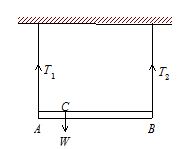
Solution
For equilibrium W = T1 + T2 … (i)
where W is the weight, and T1 and T2 tensions in the wires.
Taking moments about C
T1 (AC) = T2 (BC) … (ii)
(i) If F1 and F2 are the elastic stresses in the two wires, their areas of cross-sections are a1&a2 respectively then T1 = F1a1 and T2 = F2a2
Substituting in equation (ii)
F1a1 (AC) = F2a2 (BC)
If the stresses in the two wires are equal,
F1 = F2
a1 X AC = a2 x BC
1 x AC = 0.2 x BC
AC = 2 BC
AC = \frac{\text{2}}{\text{3}}\ \,\text{AB}\,\,\ =\,\,\ \frac{\text{4}}{\text{3}}\,\ \text{m}
The weight must be suspended at \displaystyle \frac{4}{3} m from steel wire.
(ii) Strain = \frac{{\text{increase}\,\,\ \text{in}\,\,\ \text{length}}}{{\text{original}\ \,\,\text{length}}}\ =\ \frac{{\text{ }\!\!\Delta\!\!\text{ L}}}{\text{L}}
Y = \frac{{\text{stress}}}{{\text{strain}}}\,=\ \,\frac{{\text{stress}}}{{\frac{{\text{ }\!\!\Delta\!\!\text{ L}}}{\text{L}}}}
stress = \text{Y}\ \cdot \ \frac{{\text{ }\!\!\Delta\!\!\text{ L}}}{\text{L}}
Tension = Stress X area = aY \frac{{\text{ }\!\!\Delta\!\!\text{ L}}}{\text{L}}
Hence for two wires
T1 = a1Y1 \frac{{\Delta {{L}_{1}}}}{L} , T2 = a2Y2 \frac{{\Delta {{L}_{2}}}}{L} Substituting in equation (ii),
{{a}_{1}}{{Y}_{1}}\frac{{\Delta {{L}_{1}}}}{L}\ \cdot \ AC = {{a}_{2}}{{Y}_{2}},\ \frac{{\Delta {{L}_{2}}}}{L}\ \cdot \ BC
If the strain in the two wires are equal
\frac{{\Delta {{L}_{1}}}}{L}\ =\ \frac{{\Delta {{L}_{2}}}}{L}
a1Y1 (AC) = a2Y2 (BC)
1 x 20 x 1010x AC = 0.2 X 10 X 1010X BC
AC = BC
AC = 1 m
The weight must be suspended at the midpoint of the rod.
Illustration
A slightly tapering wire of length L and end radii ‘a’ and ‘b’ is subjected to stretching forces F as shown in Figure. If Y is Young’s modulus, calculate the extension produced in the wire.
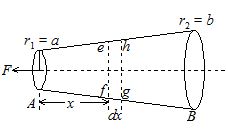
Solution:
Consider a small element of width dx, radius r situated at a distance x from A. The gradient in radius is uniform. Let it be k.
k = \frac{{b\ -\ a}}{L} … (i)
If r is the radius of the elementary portion at ef and (r + dr) at gh, then
k = \frac{{dr}}{{dx}} … (ii)
\frac{{dr}}{{dx}}\ \,\,=\,\,\ \frac{{b\ -\ a}}{L} … (iii)
dx = \frac{{dr}}{k}
If dl is the extension produced in length dx due to stretching force F using the relation
Y = \frac{{\frac{F}{A}}}{{\frac{{\Delta L}}{L}}} we get DL = \frac{{FL}}{{AY}}
d l = \frac{{F\ \cdot \ dx}}{{\pi {{r}^{2}}Y}} = \frac{{F\ \cdot \ dr}}{{\pi {{r}^{2}}Yk}} since dx = \frac{{dr}}{k}
The variable on R.H.S. is r which varies from a to b.
Total extension produced = \ \int{{\ \text{d}l\ =\ }}\int\limits_{a}^{b}{{\frac{{Fdr}}{{\pi {{r}^{2}}Yk}}}}
l = \frac{F}{{\pi Yk}}\ \int\limits_{a}^{b}{{\frac{{dr}}{{{{r}^{2}}}}}} = -\frac{F}{{\pi Yk}}\ \left[ {\frac{1}{r}} \right]_{a}^{b}= \frac{F}{{\pi Yk}}\ \left[ {\frac{1}{a}\ -\ \frac{1}{b}} \right] = \frac{{F(b\ -\ a)}}{{\pi Ykab}}
But k = \frac{{b\ -\ a}}{L}
l = \frac{{F.L}}{{\pi Yab}}
Illustration
A sphere of radius 0.1 m and mass 8p kg is attached to the lower end of a steel wire of length 5 m and diameter 10–3m. The wire is suspended from 5.22 m high ceiling of a room. When the sphere is made to swing as a simple pendulum, it just grazes the floor at its lowest point. Calculate the velocity of the sphere at the lowest position. Young’s modulus of steel is 1.994 x 1011 N/m2.
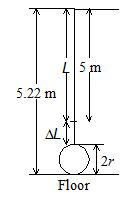
Solution: The situation is shown in Let Dl be the extension of wire at mean position when oscillating and T is the tension.
Y = \frac{{T/A}}{{\Delta L/L}} or T = \frac{{YA\Delta L}}{L}
ΔL = 5.22 – (L + 2r)
= 5.22 – (5 + 2 ´1) = 0.02 m
T = \frac{{1.994\ \times \ {{{10}}^{{11}}}\ \times \ \pi {{{(5\ \times \ {{{10}}^{{-4}}})}}^{2}}\ \times \ 0.02}}{5} = 199.4π N.
At mean position T–Mg = \frac{{M{{v}^{2}}}}{R}
R, the radius of circular path of oscillating sphere = 5.22 -1 = 5.12 m
Mg = 8p x 8 = 78.4p N
(199.4p-4p) = \frac{{8\pi {{v}^{2}}}}{{5.12}}
v2 = \frac{{121\ \times \ 5.12}}{8} = 72.44
v = 8.8 m/sec
Illustration
A thin ring of radius R is made of a material, which has density r and Young’s modulus Y. If the ring is rotated about its centre in its own plane with an angular velocity w, find the small increase in its radius.
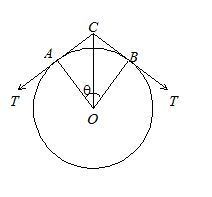
Solution
Consider a small element AB of length dl. If a is the area of cross-section the mass will be adlr. The centrifugal force is equal to a dlr×w2R
If the consequent tension in the wire is T, the radial component is 2T sin \frac{\theta }{2}. For small angle q this can be written as 2T× \frac{\theta }{2}= Tq
T ×q = adlρω2R = a Rθρω2R
T = aρω2R2
If the increase in radius is dR, the increase in circumference is 2π(R + dR) – 2πR = 2πdR
Strain = \frac{{2\pi dR}}{{2\pi R}}\ =\ \frac{{dR}}{R}
Young’s modulus Y = \frac{{\frac{T}{a}}}{{\frac{{dR}}{R}}}
T = a Y× \frac{{dR}}{R}
a Y× \frac{{dR}}{R} = a ρω2R2
dR = \frac{{\rho {{\omega }^{2}}{{R}^{2}}}}{Y}
Practice Questions (Basic Level)
Q.1
Which of the following substance has the highest elasticity
(a) steel (b) copper (c) rubber (d) sponge
Ans. (a)
Q.2
An elastic metal rod will not change its length when it
(a) falls vertically under its weight
(b) is pulled along its length by a force acting at one end
(c) rotates about an axis at one end
(d) slides on a rough surface
Ans. (a)
Q.3
Which of the following substances has the highest value of the Young’s modulus:
(a) Steel (b) Rubber (c) Wood (d) Plastic
Ans. (a)
Q.4
Energy stored per unit volume in a stretched wire is:
(a) ½ Load ´ Strain
(b) Load ´ Strain
(b) Stress ´ Strain
(d) ½ Stress ´ Strain
Ans. (d)
Q.5
The following four wires are made of the same material. Which of these will have the largest extension when the same tension is applied:
(a) Length = 50 cm and diameter = 0.5 mm
(b) Length = 100 cm and diameter = 1 mm
(c) Length = 200 cm and diameter = 2 mm
(d) Length = 300 cm and diameter = 3 mm
Ans. (a)
Q.6
A wire (Y = 2 ´ 1011 N/m2) has length 1 m and area of cross-section 1 mm2; the work required to increase its length by 2 mm is:
(a) 0.4 kJ (b) 40 kJ (c) 4 kJ (d) 400 kJ
Ans. (d)
Q.7
A metal wire of length L, area of cross-section A and Young modulus Y is stretched by a variable force F, such that F is always slightly greater than elastic force of resistance in the wire. If the elongation of the wire is l, then which of the following is incorrect.
(a) the work done by F is \frac{{YA{{l}^{\text{2}}}}}{{2L}}
(b) the work done by F is \frac{{YA{{l}^{\text{2}}}}}{L}
(c) the elastic potential energy stored in the wire is \frac{{YA{{l}^{\text{2}}}}}{{2L}}
(d) no heat is produced during the elongation
Ans. (b)
Q.8
A metal wire of length L, area of cross-section A and Young modulus Y behaves as a spring of spring constant k.
(a) k = YA/L (b) k = 2YA/L (c) K = YA/2L (d) K = YL/A
Ans. (a)
Q.9
A uniform rod of mass m, length L, area of cross-section A and Young modulus Y hangs from the ceiling. Its elongation under its own weight will be
(a) zero
(b) \frac{{mgL}}{{2AY}}
(c) \frac{{mgL}}{{AY}}
(d) \frac{{2mgL}}{{AY}}
Ans. (b)
comprehension (Q.10 to Q.12)
A structural steel rod has a radius of 10 mm and a length of 1 m. A 100 kN force stretches it along its length. Calculate
Given that the Young’s modulus of elasticity of the structural steel is 2.0 ´ 1011 N/m2.
Q.10
the stress
(a) 3.18 ´ 108 N/m2
(b) 5.36 ´ 108 N/m2
(c) 0.83 ´ 108 N/m2
(d) 9.27 ´ 108 N/m2
Ans (a)
Q.11
elongation and
(a) 0.35 mm
(b) 1.59 mm
(c) 3.43 mm
(d) 7.28 mm
Ans (b)
Q.12
percentage strain on the rod.
(a) 1.568%
(b) 0.355%
(c) 1.456%
(d) 0.159%
Ans (d)
Q.13
Compute the bulk modulus of water from the following data:
Initial volume = 100 litre, pressure increase = 100 atmosphere;
Final volume = 100.5 litre. (1 atmosphere = 1.013 ´ 105 Pa).
(a) 1.856 ´ 109 Pa
(b) 0.386 ´ 109 Pa
(c) 2.026 ´ 109 Pa
(d) 2.46 ´ 109 Pa
Ans (c)
comprehension (Q.13 to Q.14)
Calculate the elongations of
Q.13
a copper wire of 1.4 mm diameter and
(a) 0.5 ´ 10-3 m
(b) 0.1 ´ 10-3 m
(c) 0.2 ´ 10-3 m
(d) 1.7 ´ 10-3 m
Ans (d)
Q.14
analuminium wire of 1 mm diameter as shown in figure.
Young’s modulus of copper and aluminium are
11 ´ 1010 N/m2 and 7 ´ 1010 N/m2 respectively.
(a) 0.36 ´ 10-3 m
(b) 1.96 ´ 10-3 m
(c) 5.74 ´ 10-3 m
(d) 2.45 ´ 10-3 m
Ans (b)
Q.15
The edges of an aluminum cube are 10 cm long. One face of the cube is firmly fixed to a vertical wall. A mass of 100 kg is then attached to the opposite face of the cube. The shear modulus of aluminum is 25 G Pa. What is the vertical deflection of this face?
(g = 10 m/s2, 1 Pa = 1 N/m2).
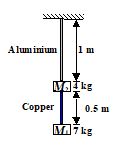
(a) 0.6 ´ 10-7 m
(b) 4 ´ 10-7 m
(c) 7.5 ´ 10-7 m
(d) 1.764 ´ 10-7 m
Ans (b)
Practice Questions (JEE Main Level)
Q.1
The length of a metal wire is l1 when the tension in it is T1 and is l2 when the tension is T2. The natural length of the wire is
(a) \frac{{{{l}_{1}}+{{l}_{2}}}}{2}
(b) \sqrt{{{{l}_{1}}{{l}_{2}}}}
(c) \frac{{{{l}_{1}}{{T}_{2}}-{{l}_{2}}{{T}_{1}}}}{{{{T}_{2}}-{{T}_{1}}}}
(d) \frac{{{{l}_{1}}{{T}_{2}}+{{l}_{2}}{{T}_{1}}}}{{{{T}_{2}}+{{T}_{1}}}}
Ans. (c)
Q.2
One end of a uniform wire of length L and of weight W is attached rigidly to a point in the roof and a weight W1 is suspended from its lower end. If S is the area of cross-section of the wire, the stress in the wire at height (3L/4) from its lower end is
(a) W1/S (b) [W1 + W/4]S (c) (W1 + 3W/4]/S (d) (W1 + W2)/S
Ans. (c)
Q.3
A stone of 0.5 kg mass is attached to one end of a 0.8 m long aluminium wire of 0.7 mm diameter and suspended vertically. The stone is now rotated in a horizontal plane at a rate such that the wire makes an angle of 85o with the vertical. Find the increase in the length of the wire.
[Young’s modulus of aluminium wire = 7 ´ 1010 N/m2; sin 85o = 0.9962 and cos 85o = 0.0872]
(a) 1.668 ´ 10-3 m
(b) 5.336 ´ 10-3 m
(c) 10.643 ´ 10-3 m
(d) 0.543 ´ 10-3 m
Ans (a)
Q.4
A sphere of radius 0.1 m and mass 8p kg is attached to the lower end of a steel wire of length 5.0 m and diameter 10-3 m. The wire is suspended from 5.22 m high ceiling of a room. When the sphere is made to swing as a simple pendulum, it just grazes the floor at its lowest point. Calculate the velocity of the sphere at the lowest position.
[Y for steel = 1.994 ´ 1011 N/m2]
(a) 0.3 m/s
(b) 2.5 m/s
(c) 8.8 m/s
(d) 1.6 m/s
Ans (c)
Q.5
Find the elastic deformation energy of a steel rod of mass m = 5 kg when stretched to a tensile strain e = 10-3. Density of steel (r) = 7800 kg m-3 and E (Young’s modulus)
= 2 ´ 1011 N/m2
(a) U = 24 J
(b) U = 38 J
(c) U = 64 J
(d) U = 58 J
Ans (c)
comprehension (Q.6 to Q.7)
A light rod of length 200 cm is suspended from the ceiling horizontally by means of two vertical wires of equal length tied to its ends. One of the wires is made of steel and is of cross-section 0.1 cm2 and the other of brass of cross-section 0.2 cm2. Along the rod at what distance may a weight be hung to produce [Y for brass and steel are 10 ´ 1011 and 20 ´ 1011 dyne/cm2 respectively.]
Q.6
equal stress in both the wires
(a) \frac{4}{3} m from steel wire
(b) \frac{4}{3} m from steel wire
(c) \frac{4}{3} m from steel wire
(d) \frac{4}{3} m from steel wire
Ans (d)
Q.7
equal strains in both the wires?
(a) 1 m from both the wires.
(b) 10 m from both the wires.
(c) 5 m from both the wires.
(d) 20 m from both the wires.
Ans (a)
Q.8
The wires A and B shown in the figure are made of the same material, and have radii rA and rB respectively. The block between them has a mass m. When the force F is mg/3, one of the wire breaks. Then which of the following is not correct?

(a) A will break before B if rA = rB.
(b) A will break before B if rA < 2rB.
(c) Either A or B may break rA = 2rB.
(d) The lengths of A and B must be known to predict which wire will break
Ans. (d)
Practice Questions (JEE Advance Level)
Q.1
The deformation of a wire under its own weight compared to the deformation of same wire subjected to a load equal to weight of the wire is
(a) same (b) one third (c) half (d) one fourth
Ans. (b)
Q.2
A rod AD consisting of three segments AB, BC and CD joined together is hanging vertically from a fixed support at A. The lengths of the segments are respectively 0.1 m, 0.2 m and 0.15 m. The cross-section of the rod is uniform and 10-4 m2. A weight of 10 kg is hung from D. Calculate the displacements of points B, C and D if YAB= 2.5 ´ 1010 N/m2, YBC= 4 ´ 1010 N/m2 and YCD= 1 ´ 1010 N/m2.
(Neglect weight of the rod.)
(a) Displacement of B = 3.92 ´ 10-6 m;Displacement of C = 8.82 ´ 10-6 m ;Displacement of D = 23.5 ´ 10-6 m
(b) Displacement of B = 8.92 ´ 10-6 m;Displacement of C = 8.82 ´ 10-6 m ;Displacement of D = 0.65 ´ 10-6 m
(c) Displacement of B = 3.92 ´ 10-6 m;Displacement of C = 7.47 ´ 10-6 m ;Displacement of D = 23.5 ´ 10-6 m
(d) Displacement of B = 2.75 ´ 10-6 m;Displacement of C = 8.82 ´ 10-6 m ;Displacement of D = 23.5 ´ 10-6 m
Ans. (b)
Q.3
One end of a long metallic wire of length L is tied to the ceiling. The other end is tied to a massless spring of spring constant k. A mass m hangs freely form the free of the spring. The area of cross-section and the Young modulus of the wire are A and Y respectively. If the mass is slightly pulled down and released, it will oscillate with a period T equal to
(a) 2\,\pi \sqrt{{m/k}}
(b) 2\pi \sqrt{{\frac{{m(YA+kL)}}{{YAk}}}}
(c) 2\pi \sqrt{{mYA/kL}}
(d) 2\pi \sqrt{{mL/YA}}
Ans. (b)
Q.4
A heavy plank of mass 100 kg hangs on three vertical wires of equal length arranged symmetrically. Find the tensions in the wires if the middle wire is of steel and the other two are of copper. All the wires have the same cross-section. Take the modulus of elasticity of steel to be double that of copper.
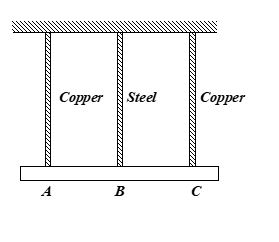
(a) Tcopper= 250 N, Tsteel= 500 N
(b) Tcopper= 640 N, Tsteel= 500 N
(c) Tcopper= 250 N, Tsteel= 453 N
(d) Tcopper= 500 N, Tsteel= 200 N
Ans (a)
